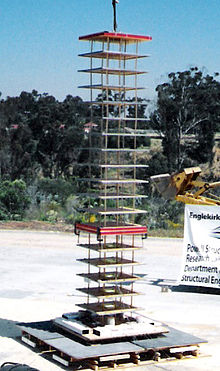Earthquake engineering

Earthquake engineering is the study of the behavior of building structures subject to earthquake impacts. It is a subset of civil engineering.
Objectives of the earthquake engineering
[change | change source]The main goals of earthquake engineering are:
- Understand what happens between buildings and the ground.
- Understand what strong earthquakes or tsunamis might do to building structures.
- Design, build and maintain structures to last during an earthquake while following building codes.[1]

Tools
[change | change source]A properly engineered structure does not necessarily have to be extremely strong or expensive.
The most powerful and affordable tools of earthquake engineering are vibration control technologies and, in particular, base isolation.
To test seismic performance of a building structure with experiments, it may be put on a shake-table that behaves like the earth shaking. The earliest shake-table experiments were performed more than a century ago. [2]
Tsunami preparedness and protection
[change | change source]Tsunami or a chain of fast moving waves in the ocean caused, mostly, by powerful earthquakes is a very serious challenge for people's safety and for tsunami protection of buildings and civil infrastructure. Those waves can flood coastal areas, destroy houses and even swipe away whole towns.[3]
Though tsunami can not be prevented, there are warning systems developed recently[4] which warn the population before the big waves reach the land to let them enough time to rush to safety.
Notes
[change | change source]- ↑ Berg, Glen V. (1983). Seismic Design Codes and Procedures. EERI. ISBN 978-0-943198-25-5.
- ↑ Omori, F. (1900). Seismic Experiments on the Fracturing and Overturning of Columns. Publ. Earthquake Invest. Comm. In Foreign Languages, N.4, Tokyo.
- ↑ "USGS Poster of the Near the East Coast of Honshu, Japan Earthquake of 11 March 2011 - Magnitude 8.9". Archived from the original on 2011-03-11. Retrieved 2017-08-31.
{{cite web}}: CS1 maint: bot: original URL status unknown (link) - ↑ "Pacific Tsunamy Warning Center". Archived from the original on 2011-03-13. Retrieved 2020-09-15.
[1]Ahmadi Maleki, M., Emami, M. Application of SVM for investigation of factors affecting compressive strength and consistency of geopolymer concretes. Journal of civil Engineering and Materials Application, 2019; 3(2): 95-101. doi: 10.22034/jcema.2019.92507
Related pages
[change | change source]- ↑ Naseri, Farzad; Bagherzadeh Khalkhali, Ahad (2018-10-01). "Evaluation of Seismic Performance of Concrete Gravity Dams Under Soil-structure-reservoir Interaction Exposed to Vertical Component of Near-field Earthquakes During Impounding Case study: Pine Flat Dam". Journal of Civil Engineering and Materials Application. 2 (4): 181–191.

